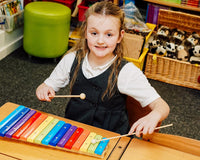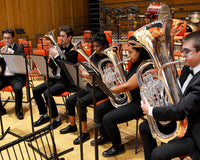The percussion family includes all the instruments you can play either by rattling, shaking or striking. These can be many different types, shapes and sizes and crafted from a variety of materials. We have compiled the most common percussion instruments and performance techniques.
Check out our range of drums and percussion: HERE
The Instruments
- Drum – a drum is a cylindrical instrument made of a variety of materials including wood, metal, plastics and animal skin. The tone depends on materials, size and depth of the drum. Drum is usually topped with a skin or head on both ends.
- Bass Drum – the biggest drum on the drum set. This drum is played by your feet using the bass drum pedal. Bass drum usually accentuates the beat and gives it a pulse rather than tone.
- Bass Drum pedal – consisting of a foot pad, spring and beater the bass drum pedal is used to kick the bass drum.
- Brooms – a certain style of drum stick that incorporates many small sticks together in one. Brooms are similar to brushes, however, instead of wires they use wooden sticks.
- Brushes – this is a drum stick that is made with thin wires that fan out. Wires can be extended and then hidden again when not playing. Often used in softer styles of music such as Jazz and slow ballads. Brushes can add a little bit extra and create a very unique feel within a piece of music.
- Chimes – these create very light and high pitched, bell like sounds. Chimes consist of cylindrical metal rods that are hung close together on a bar and each will have a different pitch.
- Chime bars – chime bars, similar to glockenspiels are tuned metal plates mounted on a wooden resonator. Chime bars can be taken apart individually, therefore involving a multiple players to join in. These are also player with a set of beaters.
- Claves – usually a pair of quite thick wooden sticks that make a noise when struck together.
- Conga – Latin percussion that create a distinctive tone and is similar to bongos and djembes. These drums feature a long body made of wood and the top is made of animal skin.
- Cymbal/Crash Cymbal – cymbals are used in practically any type of music. Crash cymbals will usually produce a much sharper, louder sound than normal cymbals and are usually used for accents. There are many different types of cymbals such as hi hats, crashes, rides, splashes that will all produce a slightly different sound.
- Cross Stick – cross sticking involves hitting your stick on the rim of the drum to create a unique sound, fairly similar to wood block. These can also be very popular for drumming along to softer styles of music.
- Cymbal bell – the centre of the cymbal where it is the thickest. This will often have a different pitch to it.
- Djembe – African percussion hand drum creating a unusual tone when played. These are crafted from wood and topped with animal skin, similar to bongos. Hourglass shaped, these drums come in a variety of sizes and colours.
- Double Bass Drum – particularly popular in progressive rock, heavy rock and different types of metal, this refers to using either two double bass drums or a double bass pedal.
- Double Bass Pedal – bass drum that consists of two double bass pedals and two beaters joined together allowing for double bass drumming. These are more popular than using two bass drums at the same time.
- Drum skin – covers both ends of the drum. There are two types of drum skins – batter skin and resonator skin. Batter skin is the side of the drum that you hit and the resonator skin is at the bottom of the drum that allows for the sound to resonate. Drum skins are tightened by tension rods and tightening/loosening these changes the pitch of the drum. Resonate skins are usually tuned differently to batter skins.
- Glockenspiel – an instrument from a percussion family consisting of tuned metal plates set out similar to a piano keyboard. Glockenspiels create a twinkly, bell-like sound and can be of a different register. This instrument is played by a pair of beaters.
- Gong – a large cymbal that produces a large, shimmering sound, originating from Japan. Gongs are played with large mallets and must be warmed up before they are hit.
- Mallets – a stick with a special tip that can be made of fabric, rubber, plastic or wood. Mallets are used to create different and unusual sounds on the drum. You can use these practically anywhere.
- Maracas – these are handheld percussion instruments that are used just like shakers. Maracas can be different shape and size and come in a variety of patterns and colours. Usually made of wood or plastic and are filled with beans. Commonly used in Latin styles of music.
- Piccolo Snare – a very thin drum that is tuned very tight. This creates a very tight, cracking sound.
- Practice Pad – these are placed over drum heads to and imitate the real drum. Practice pads muffle the sound so that drummers can have a quieter practice.
- Snare Wires – a set of metal coils stretched out across the resonant head of a snare drum. Snare wires are what gives the snare drum its loud crack.
- Throne - a stool that a drummer sits on.
- Tom Tom – tom toms produce a specific tone and are skinned on both ends. Toms are placed around the bass drum within a drum set up. These can be different in sizes and can be tuned in any style.
- Wood blocks – wooden cubes that are hollow in order to produce a unique tone. These percussion instruments can be used in any style of music and their tone depends on the thickness of the blocks.
- Xylophone – this instrument consists of wooden bars that are struck by mallets. The note layout usually replicates that of a keyboard and notes are tuned in a similar pitch. The term Xylophone can also include marimba, balafon and other similar instruments.
Performance techniques
- American Grip – holding the drum sticks with a certain grip, palms facing down. Using this technique elbows are relaxed by your sides and the sticks make a 45 degree angle. This is commonly used when performing rock music.
- Broken up Beats – these are drum beats that are played with unusual patters as oppose to regular strokes. These add completely new flavours and sounds to the generic beat.
- Drum break/Drum solo/Drum fill – a pause in a song where the drummer gets a chance to play a small pattern allowing for the drummer to express themselves and add some creative flair to the performance.
- French Grip – a technique that involves holding the sticks close together with your palms facing up. Commonly used for fast drumming and lighter genres of music.
- Germanium Grip – holding the sticks in a matched grip, palms facing down. Elbows are sticking out slightly and sticks create a 90 degree angle. This style is very popular in marching bands and allows for more power when hitting the drum.
- Ghost notes – usually played in-between louder notes to spice up the drum beat and make it more authentic. Ghost notes are felt as you can hardly hear them, however, they make the beat feel richer.
- Matched Grip – holding the drum sticks equally with both hands. French grip, American grip and Germanium grip all fall under the category of matched grip as all three involve mirroring the left and right hands when holding a stick.
- Roll – a technique used by drummers to produce a constant sound on the drum. Rolls can be played on any drums with single strokes, double strokes, triple strokes, multiple strokes or buzz roll. Commonly, rolls are played on a snare drum and used in all styles of music.
- Traditional Grip – a style of holding your sticks in which your dominant hand uses American grip while your weaker hand holds the stick upside down.
If you have any questions, please don't hesitate to contact our team: sales@normans.co.uk















